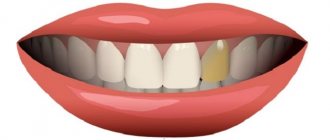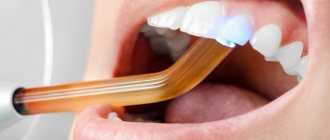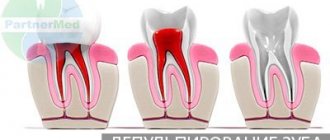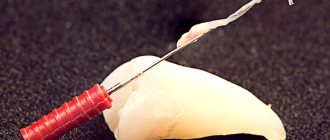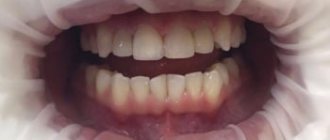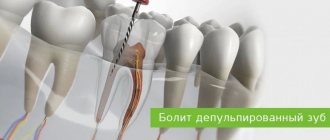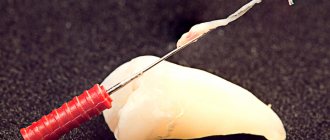Author of the article:
Soldatova Lyudmila Nikolaevna
Candidate of Medical Sciences, Professor of the Department of Clinical Dentistry of the St. Petersburg Medical and Social Institute, Chief Physician of the Alfa-Dent Dental Clinic, St. Petersburg
Whitening a pulpless tooth differs significantly from the procedure performed on healthy teeth. In the usual sense, the creation of a snow-white smile occurs with the help of a special gel, where the active substance is hydrogen peroxide in various concentrations. The composition is applied to the surface of the enamel and left for some time. In this case, additional activators can be used - laser, ultraviolet, cold light from a LED lamp, and so on. All this is necessary for oxygen to begin to be released from the gel, which discolors the yellow pigment.
Whitening a dead tooth is also done using hydrogen peroxide, but the procedure itself is radically different. Let's figure out why it is needed and how the treatment works.
Causes of darkening of pulpless teeth
The procedure is carried out solely at the request of the patient, as it mainly serves only an aesthetic function. Most often, forced lightening is required for dead incisors or fangs, since they are always visible, and if the shade of the enamel differs even by a couple of tones, it will be noticeable.
Teeth from which the pulp, that is, a collection of blood vessels and nerve endings, have been removed are considered dead. It is because of them that we feel pain, which warns of the presence of problems: the development of caries, internal trauma, etc.
In the absence of pulp, hard tissues cease to receive nutrition. What we see is no longer a tooth, but its shell, like a tree without roots. Such an incisor or molar will most likely not look the same, much less function. The consequences begin to be noticeable about a month after pulp removal. Dentin and enamel, as well as the main mineral part of the tooth, weaken and dry out. All these processes make the structure of solid tissue more porous.
Without constant replenishment, the tooth becomes defenseless and what was previously not a particular problem becomes more dangerous for it. It better absorbs pigments from food, for example, coffee, tea, alcohol, colored lemonades, berries and fruits, chocolate and other products with a high content of dyes. A pulpless tooth is like a sponge, so dyes accumulate in it faster, which means that after some time its shade begins to differ from the general tone of other teeth. If this is the reason for the color change, then standard whitening with an active gel is performed.
But there are also more complex problems when a canine or molar darkens from the inside. This happens precisely because of the removal of the pulp. Usually, those nerves that are damaged for one reason or another or interfere with the normal treatment of diseases such as tooth decay are removed. This removal may damage blood vessels, causing bleeding inside the canal. The dentin of a healthy tooth stains even more quickly than the enamel of dead hard tissue. Due to bleeding, the tooth becomes red and sometimes has a purple tint. In this case, standard bleaching will not help, since it mainly affects the outer layers of the fabric.
Methods for solving the problem
What to do if the tooth darkens after removal of the nerve, the doctor decides based on the results of the examination and diagnosis. There are several methods for restoring the natural color of enamel.
- In-canal bleaching. Allows you to lighten teeth for a long time – up to a year. A simple procedure in most cases gives good results, but has contraindications. These include gum disease and enamel hypersensitivity.
- Extension with composite materials. Widely used when a filling falls out of a darkened tooth in cases where re-filling is impractical. The doctor removes the damaged tissue and fills the voids with a composite of a suitable shade. If you follow hygiene rules and avoid products with dyes, the tab will retain its attractive appearance for a long time.
- Installation of a microprosthesis. A radical method of solving a problem. The tooth is prepared and polished, after which a metal-free or metal-ceramic crown is installed on it. Its service life is more than 15 years.
The choice of restoration method depends on the location of the darkened tooth, the cause of the discoloration of the enamel, the age and health of the patient.
How to whiten a darkened tooth
For single whitening, none of the home methods will work, be it professional gels with trays or traditional methods. You should not risk the health of your teeth; if one of them becomes very dark, contact your dentist, a specialist will select the right course of treatment. The procedure must be carried out so as not to affect the remaining teeth. Or if you whiten everything at once, the dead tooth needs to be given special attention. This is only possible in an office setting.
Hydrogen peroxide will also serve as a bleaching agent; when the chemical reaction is activated, oxygen neutralizes pigments in the enamel and even penetrates into dentin. It is important to work with peroxide carefully. If handled improperly, peroxide can damage the enamel or cause a chemical burn to the mucous membrane. The only thing that can be done here is to provide maximum protection and reduce the concentration of the substance. In a whitening gel for standard procedures, the mass fraction of the active substance reaches 40%. This is enough to quickly get rid of yellowness, but not damage the enamel. You can also try mouthwashes. For pulpless teeth, such a concentration will be excessive, so gels with a minimal peroxide content are used here.
Before you begin the procedure, the doctor will prepare you for it; this is necessary for safety. A special retainer is placed in the mouth, and the gums are treated with varnish, which forms a protective film on the teeth. After all, a gel is applied to the dead tooth; a laser is most often used to activate the reaction, which is why active oxygen begins to quickly release from the composition - this reduces the time of exposure to chemicals. It is the laser that allows targeted treatment of one tooth, so it is better suited than photo-bleaching, which is designed to lighten the entire row.
For internal damage, intracanal bleaching is used. The principle of the procedure is very simple. The active gel is placed inside the root canal, which is previously cleared and expanded. In such cases, the pulp is precisely removed, since the tooth becomes very sensitive and vulnerable. For intracanal lightening, use a gel with a peroxide concentration that does not exceed 20%. In this option, whitening takes a significant amount of time - usually several weeks. The canal opening is closed with a temporary filling, leaving the gel inside the tooth. After the tissues have changed color to the desired color, a permanent filling is placed on the tooth.
How harmful is whitening a dead tooth?
All types of whitening are, to one degree or another, harmful to teeth, both healthy and pulpless. The latter are much weaker, so the procedure is more destructive. On the other hand, such a tooth will not last more than five years and will still collapse. In this case, there are two options: install a crown or make an implant.
A crown is the most popular option due to its reasonable cost and simplicity. This is a permanent prosthesis that completely follows the shape of the tooth and allows you to restore its chewing and aesthetic functions. In most cases, ceramics or its combination with metal are used to produce crowns. It is possible to install a crown without an implant only if the dentist managed to completely preserve the roots and at least 50% of the crown of the tooth.
An implant is a more serious design than a crown. This is an almost complete replacement of the main part of the tooth and its root system. The most popular implants are made from titanium alloys, but other materials are also used for their production. The product is implanted into the bone tissue and, after complete healing, becomes an inseparable part of the jaw and a support for the crown. Usually people strive to keep their own teeth for as long as possible without replacing them with dentures. And the main reason is not the high cost of the operation.
For quite a long time, it was believed that your own teeth are always better than artificial ones. Unfortunately, today it is almost impossible to maintain a healthy smile until old age; sooner or later the hard tissue weakens and begins to crumble. This happens around the age of fifty. So in many cases it is necessary to resort to implants; they are even needed to fix removable dentures. But the fact is that with age, the body tolerates such operations less well.
Therefore, if you have had the pulp removed and the tooth has turned black, one of the reasonable solutions would be to replace it with an implant, without wasting time and money on whitening without replacing it in time. But in any case, the dentist always has the final say.
How to keep your teeth healthy
To avoid unpleasant situations as much as possible, carefully monitor your dental health. Professional products from the ASEPTA series will help you with your care. In the line you will find remineralizing pastes that restore the health of enamel, rinses that prevent gum inflammation and other effective products.
Why do teeth darken after nerve removal?
Many people are willing to give a lot for a beautiful and snow-white smile, and when a tooth becomes darkened as a result of nerve removal or other dental procedures, to put it mildly, they are very upset. This is a very common and widespread phenomenon, caused by staining of the bone tissue from the inside.
Why is this happening?
In fact, it all comes down to three main points.
- First of all, this is incomplete removal of the nerve. Even a small piece of remaining living tissue begins to rot over time - the waste products of bacteria are precisely the “dye” that leads to the darkening of a palpated tooth.
- Exactly the same detrimental effect on teeth is caused by poor-quality treatment of the cavity inside the tooth. This is already called medical negligence, which is extremely rare among professional dentists.
- Another reason why teeth darken is the use of outdated technology. To be precise, we are talking about the use of materials that contain resorcinol-formalin or silver - they have a relatively low cost and are used, as a rule, in budget clinics.
Be that as it may, if there is a fact of a change in the color of a tooth, then something needs to be done about it - ignoring it will lead to complete and, most importantly, rapid destruction of bone tissue.
There is only one answer to the question: what to do if the tooth darkens
The only right solution in such a situation is a visit to a professional dental clinic. Simply put, a previously made mistake will have to be eliminated by first performing a tooth whitening procedure from the inside. In general, this procedure takes a couple of weeks and looks like this.
- First, the existing seal is opened - the opened hole is thoroughly disinfected and washed.
- A special whitening solution is poured into the tooth, after which the hole is sealed with a temporary filling.
- After a couple of weeks, a follow-up examination is carried out and, if everything is normal, a permanent filling is installed.
If we are talking about front teeth, then a ceramic or composite veneer can be used as an alternative. The choice of one or another method of eliminating darkening is made by the doctor based on a variety of factors. Once again, it should be emphasized that such procedures are best performed in a proven and exceptionally proven dental clinic.
In our dentistry you will find professional dentists with extensive experience who are ready to make your teeth healthy and beautiful.
Clinical researches
Clinical experiments with the use of the Asepta series of products, conducted at the Ryazan State Medical University named after Academician I.P. Pavlova of the Ministry of Health and Social Development of the Russian Federation (GBOU VPO RyazSMU Ministry of Health and Social Development of Russia) have proven that the use of Asepta line products results in a decrease in complaints of discomfort, but bleeding persists when brushing teeth.
On examination, hyperemia and bleeding of the gingival papillae are noted. On the 7th day, complaints of gum bleeding persisted in 4 patients. Upon examination, a decrease in hyperemia and swelling of the gums was noted, but bleeding persisted upon probing. On day 14, 2 patients continued to complain of bleeding gums when brushing their teeth; upon examination, a significant decrease in hyperemia and swelling of the gums was noted. After the final application of the gel with propolis, normalization of clinical manifestations was revealed, which is manifested by the absence of bleeding during brushing and probing.
Sources:
- Clinical experience in using the Asepta series of products Fuchs Elena Ivanovna Assistant of the Department of Therapeutic and Pediatric Dentistry State Budgetary Educational Institution of Higher Professional Education Ryazan State Medical University named after Academician I.P. Pavlova of the Ministry of Health and Social Development of the Russian Federation (GBOU VPO RyazSMU Ministry of Health and Social Development of Russia)
- Report on determining/confirming the preventive properties of toothpaste “ASEPTA PLUS” GENTLE WHITENING” Author: doctor-researcher A.A. Leontyev, head Department of Preventive Dentistry, Doctor of Medical Sciences, Professor S.B. Ulitovsky First St. Petersburg State Medical University named after. acad. I.P. Pavlova, Department of Preventive Dentistry
- Clinical and laboratory assessment of the influence of domestic therapeutic and prophylactic toothpaste based on plant extracts on the condition of the oral cavity in patients with simple marginal gingivitis. Doctor of Medical Sciences, Professor Elovikova T.M.1, Candidate of Chemical Sciences, Associate Professor Ermishina E.Yu. 2, Doctor of Technical Sciences Associate Professor Belokonova N.A. 2 Department of Therapeutic Dentistry USMU1, Department of General Chemistry USMU2
- Report on the determination/confirmation of the preventive properties of personal oral hygiene products “ASEPTA PLUS” Remineralization doctor-researcher A.A. Leontyev, head Department of Preventive Dentistry, Doctor of Medical Sciences, Professor S.B. Ulitovsky First St. Petersburg State Medical University named after. acad. I.P. Pavlova, Department of Preventive Dentistry
Infectious disease - when a nerve is removed
There is a small risk that a tooth after root canal treatment may become infected, like other teeth. If, after treating a tooth with root canal treatment, you notice symptoms of infection (inflammation of the gums, pain “inside the gum” or “above/below the tooth,” etc.), you should immediately contact your dentist for re-treatment.
Some precautions to take after tooth nerve removal and root canal treatment
Have you treated your tooth with root canal treatment? So you must take the following precautions. Most of these instructions apply to all people, even those unlucky enough not to have undergone a root canal procedure.
- Avoid chewing foods that are too hard, such as raw nuts, on a tooth that has had a root canal.
- Brush your teeth twice a day and use dental floss or floss.
- Don't forget to rinse your mouth after meals or snacks.
- Maintain good oral hygiene (periodically changing toothpaste, visiting the dentist for teeth cleaning)
- Get rid of bad habits such as smoking tobacco.
Why do teeth turn black?
If a tooth near the gum turns black, carefully examine the remaining teeth - because most likely, it is not alone. Typically, black plaque affects all the teeth in a certain area. This may be due to the following reasons:
- Drinking coloring drinks (tea, coffee, cola) and smoking.
- Insufficient oral hygiene.
- Parasitic infections.
- Dysbacteriosis of the intestines and oral cavity (this is a typical cause of the appearance of black plaque on the teeth of children).
- Long-term use of certain medications.
- Immunodeficiency and metabolic diseases.
These and some other reasons can cause darkening of the enamel of all teeth or black plaque that literally sticks to the teeth and does not respond to a toothbrush, dental floss and other methods of cleaning teeth at home.
If you have a problem similar to that described in this article, be sure to contact our specialists. Don't diagnose yourself!
Why you should call us now:
- We will answer all your questions in 3 minutes
- Free consultation
- The average work experience of doctors is 12 years
- Convenient location of clinics
Single contact phone number: +7
Make an appointment
After three years of removing the nerve from the tooth, the tooth itches when the jaws touch
Ira, Moscow
November 29, 2020
Hello!
Now I’m 25. After three years of removing the nerve from the tooth (bottom 7), the tooth (or the gum under it, to be more specific, if you poke a toothpick between teeth 7 and 6, then it’s from the outside where the cheek is, and not from sides of the tongue, you’ll feel something wrong and you’ll want to scratch it, but it didn’t bother me, it itched only when my jaws touched. One doctor said that it could be due to an incorrect bite and first put braces on my upper jaw. I was terribly sick for two weeks. Well, the problem, of course, did not disappear. When my jaws touched, it was still the same thing - scabies. But it didn’t worry me much, since I knew that I could not close my jaws for a while, I’ll be patient for two years and everything will pass. I’ve been walking for a month, everything is the same but the problem remains. Just yesterday they put braces on the lower jaw, and some kind of cement was applied to the upper chewing 6s (as the doctor explained to me, so that my teeth would not kill each other in the process of correcting the bite) which is just below these upper 6s. ok, and now even in a relaxed state (when the jaws are not closed at all), itching appears. It’s just that this unfortunate side with this insidious 7 doesn’t itch too much (considering, to my surprise, that the other side doesn’t bother me at all after installing braces on the lower jaw), and when the “cement” 6 is added to this feeling, there’s a general “shine” ", the scabies are still the same. When I close my jaws tightly, it is generally impossible not to fidget with my jaws, it itches terribly. Is it the fault of the bite? But there was no such problem before the nerve was removed. Before installing braces, they took an x-ray in a good clinic, they said there was no allergy to the material, there was no material left in the canal, the nerve was completely removed. What could this be? Will this nightmare be corrected in two years, when the braces are removed? Today I couldn’t sleep, even in a relaxed state, this cement comes into contact just a little with the tooth and it’s already itching... not strong, because the jaws don’t touch much, but itching. If it were due to the bite, then with not too much pressure there would probably be no scabies, considering that even in a calm state I touch a specific place (the gum between the lower 6th and 7th teeth and it is at the junction of these teeth that scabies occurs... if I poke a toothpick in the middle of the gum of the 7th tooth, where my nerve was removed, neither on the outside, where the cheek is, nor on the inside, where the tongue is, I won’t feel anything abnormal... only between the teeth on the outside. Chronic diseases:
Gastritis, gastroduodenitis
The question is closed
itching
tooth itch
contact of jaws
